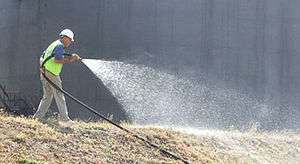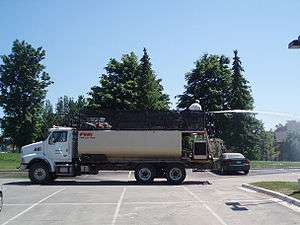Hydroseeding
Hydroseeding (or hydraulic mulch seeding, hydro-mulching, hydraseeding) is a planting process that uses a slurry of seed and mulch. It is often used as an erosion control technique on construction sites, as an alternative to the traditional process of broadcasting or sowing dry seed.[1]


Description
The hydroseeding slurry is transported in a tank, either truck-mounted or trailer-mounted and sprayed over prepared ground. Helicopters have been used to cover larger areas. Aircraft application may also be used on burned wilderness areas after a fire, and in such uses may contain only soil stabilizer to avoid introducing non-native plant species. Hydroseeding is an alternative to the traditional process of broadcasting or sowing dry seed. A study conducted along the lower Colorado River in Arizona reported that hydroseeding could be used to restore riparian vegetation in cleared land.[2]
The slurry often has other ingredients including fertilizer, tackifying agents, fiber mulch, and green dye.[3]
History
Maurice Mandell of the Connecticut Highway Department is responsible for coming up with hydroseeding. Back in the 1940s, Mandell was tinkering with ways to grow healthy grass and avoid soil erosion along the slopes of Connecticut’s expressways. He mixed up seed and water then had it sprayed over the slopes where the grass could sprout and take hold, even on a steep incline.[4]
Advantages
If planting a relatively large area, hydroseeding can be completed in a very short period of time. It can be very effective for hillsides and sloping lawns to help with erosion control and quick planting. Hydroseeding will typically cost less than planting with sod, but more than broadcast seeding. Results are often quick with high germination rates producing grass growth in about a week and mowing maintenance beginning around 3 to 4 weeks from the date of application. Fiber mulch accelerates the growing process by maintaining moisture around the seeds thereby increasing the rate of germination.[5]
See also
References
- Keating, Janis (March–April 2011). "Hydroseeding Moves Up". Erosion Control. Forester Media. 18 (2): 18–29.
- Matthew, R.G.; Michael, A.M.; Martin, M.K.; Barbara, E.R.; Gregg, M.G.; Daniel, P.B. (2011). "Direct seeding for riparian tree re-vegetation: Small-scale field study of seeding methods and irrigation techniques". Ecological Engineering. 37: 864–872. doi:10.1016/j.ecoleng.2011.01.003.
- California Department of Transportation (CalTrans). Sacramento, CA. "Construction Site Best Management Practices (BMP) Manual." Section 3, BMP No. SS-4. March 2003.
- "The History of Hydroseeding".
- West, Dawn (2006-08-21). "Planting by Hydroseeding". All About Lawns. Archived from the original on 2018-12-16.